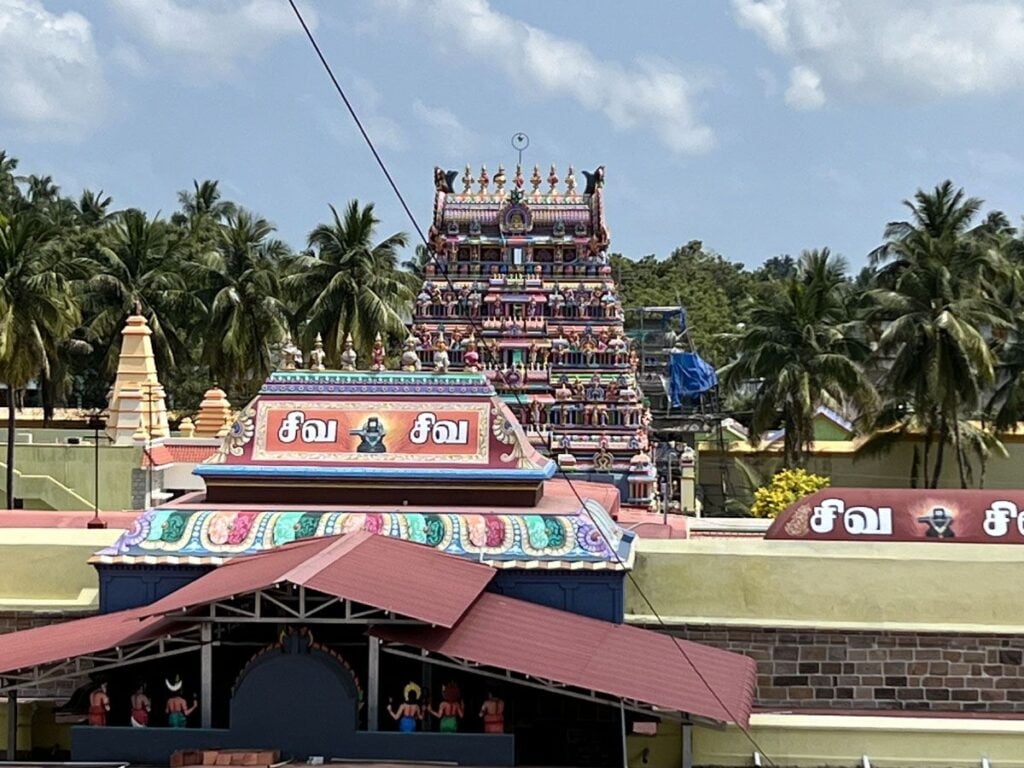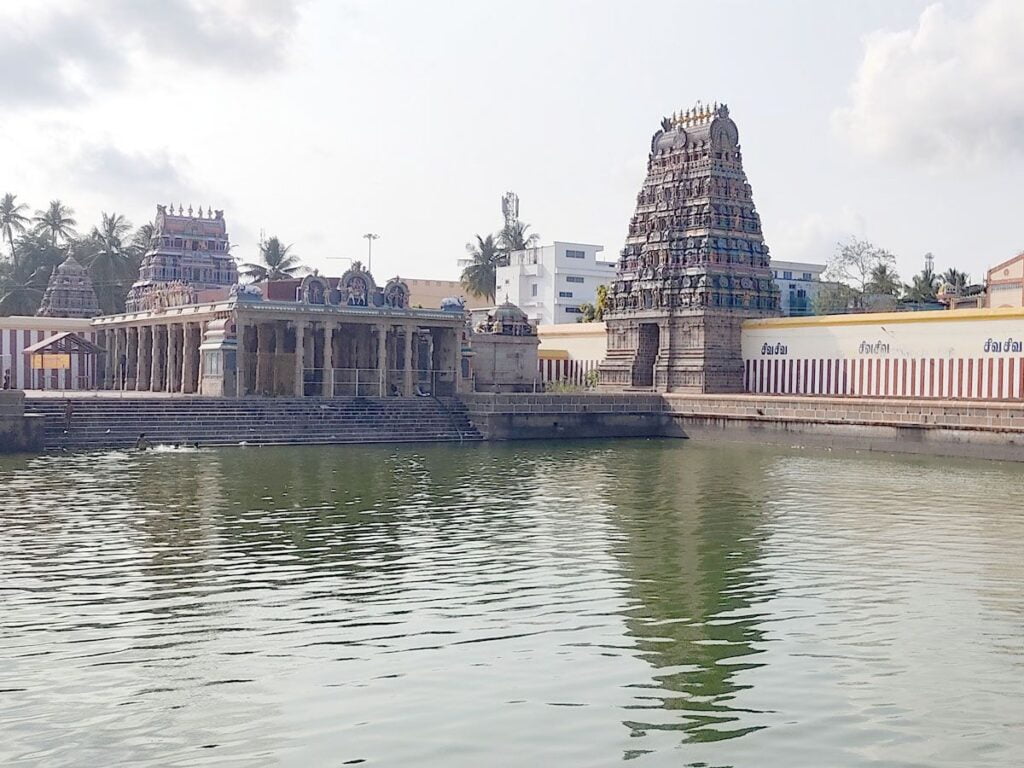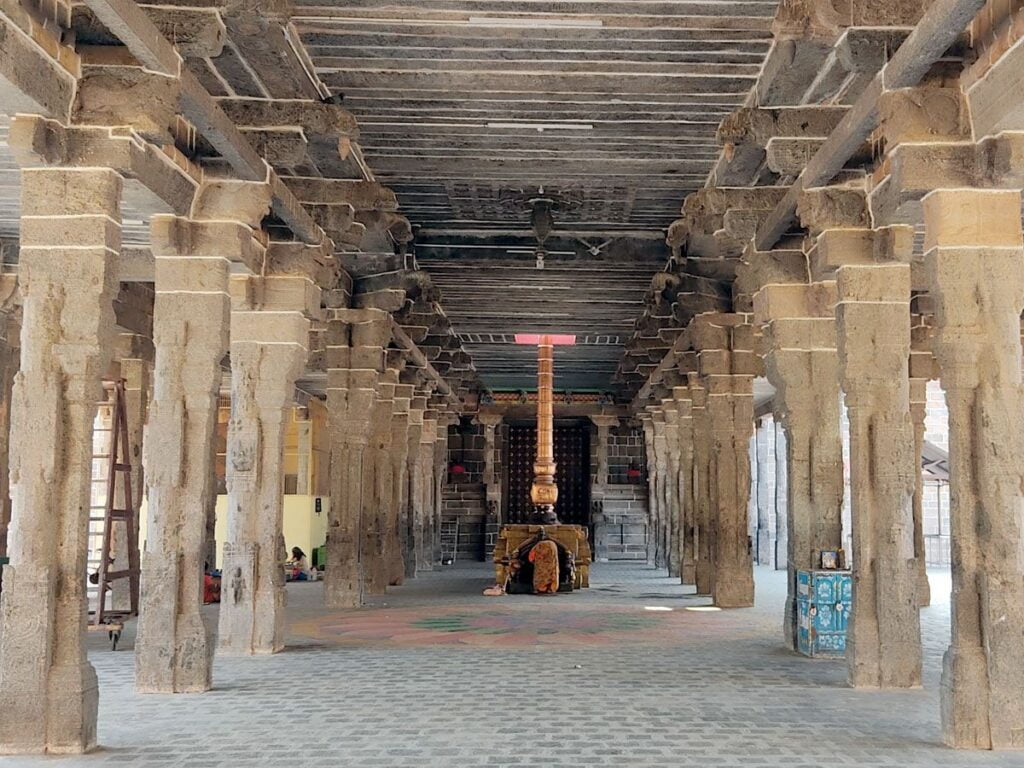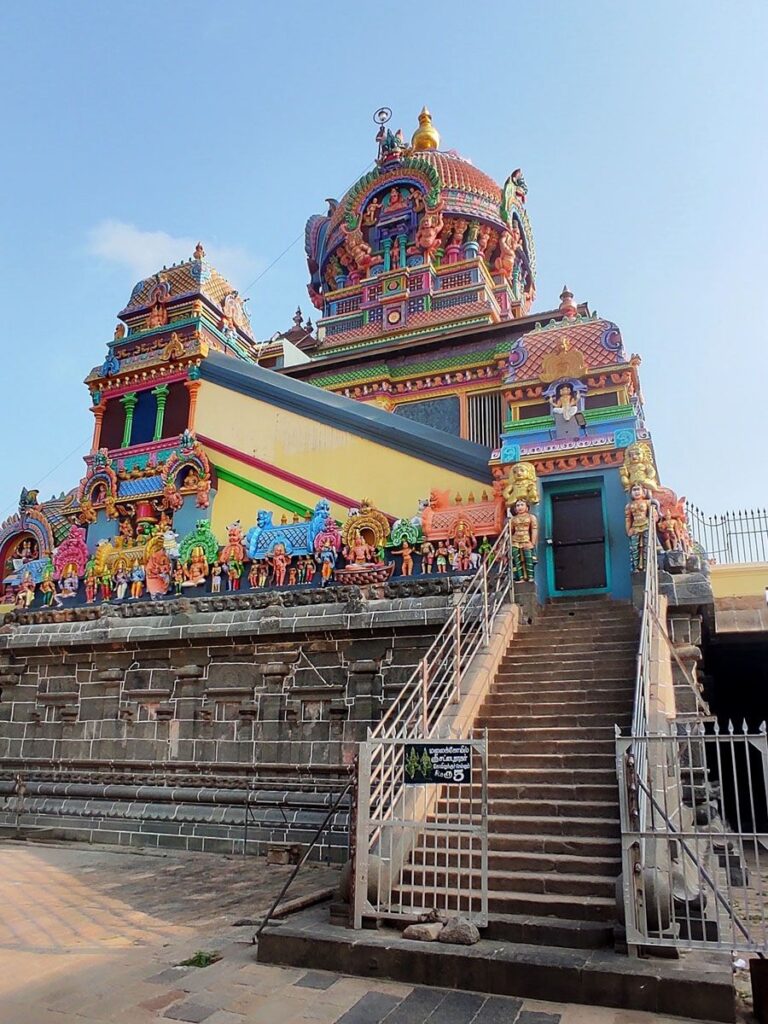Sirkali Sattainathar Temple Sirkazhi
The Sirkali Sattainathar Temple, also known as the Brahmapureeswarar Temple and the Thoniappar Temple, is a Hindu temple dedicated to Shiva located in Sirkali, Tamil Nadu, India. The temple is incarnated by the hymns of Thevaram and is classified as Paadal Petra Sthalam. It is an ancient temple complex with three different Shiva shrines in three stories.

The Bhramapureeswarar shrine is housed in the lower level. Brahmapureeswarar is accompanied by Ambal Sthira sundari/Thiripurasundari or Thirunilainayaki in Tamil. The second-level houses Periyanakar with Periyanayaki on a Thoni, hence the name Thoniappar. Sattainathar/Vatukanathar is also housed here.
The third level houses the main deity, Sattainathar, who is depicted in the form of a lingam. He is accompanied by his consort, Periyanayaki. The temple is also home to a number of other shrines, including those to Ganesha, Murugan, and Navagrahas.
Contents
- 1 Sirkali Sattainathar Temple History:
- 2 Legend of Sirkali Sattainathar Temple:
- 3 Significance of Sirkali Sattainathar Temple:
- 4 Myths of Sirkali Sattainathar Temple:
- 5 Architecture of Sirkali Sattainathar Temple:
- 6 Sirkali Sattainathar Temple Timing and Rituals:
- 7 Places to visit near Sirkali Sattainathar Temple:
- 8 FAQ:
- 8.0.1 What is the history of the Sirkali Sattainathar Temple?
- 8.0.2 What are the timings of the Sirkali Sattainathar Temple?
- 8.0.3 What is the dress code for the Sirkali Sattainathar Temple?
- 8.0.4 What are the festivals celebrated at the Sirkali Sattainathar Temple?
- 8.0.5 How to reach the Sirkali Sattainathar Temple?
- 8.0.6 What are the other places to visit near the Sirkali Sattainathar Temple?
- 8.0.7 Where to stay near the Sirkali Sattainathar Temple?
- 8.0.8 What are the restaurants near the Sirkali Sattainathar Temple?
- 9 How to reach Sirkali Sattainathar Temple:
- 10 Google Maps:
Sirkali Sattainathar Temple History:
The temple is believed to have been built by the Chola king Kulothunga Chola I (1070-1118 CE) and expanded by his successors. The temple complex is enclosed by a massive granite wall with four gopurams (gateway towers). The main gopuram, on the eastern side, is 130 feet (40 m) tall. The temple has three sanctums, one each for Shiva, his consort Parvati, and his son Ganesha.
The sanctum of Shiva is located in the center of the temple complex. The lingam (aniconic representation of Shiva) in the sanctum is known as Brahmapureeswarar. The sanctum of Parvati is located to the south of the sanctum of Shiva. The image of Parvati in the sanctum is known as Sthira Sundari. The sanctum of Ganesha is located to the north of the sanctum of Shiva. The image of Ganesha in the sanctum is known as Vinayaka.
The temple is a major pilgrimage site for Hindus. The temple is visited by thousands of devotees every day. The temple is especially crowded during the Tamil month of Chithirai (April-May) when the annual festival of the temple is celebrated.
The Sattainathar Temple is a significant example of Chola architecture. The temple is known for its intricate sculptures and beautiful paintings. The temple is a UNESCO World Heritage Site.
Here are some of the important events in the history of the Sattainathar Temple:
- 7th century CE: The temple is believed to have been built by the Chola king Kulothunga Chola I.
- 11th century CE: The temple is expanded by the Chola kings Vikrama Chola, Kulothunga Chola II, and Kulothunga Chola III.
- 13th century CE: The temple is invaded by the Muslims and damaged.
- 16th century CE: The temple is repaired and renovated by the Vijayanagara kings.
- 18th century CE: The temple is again invaded by the Muslims and damaged.
- 19th century CE: The temple is repaired and renovated by the British.
- 1987 CE: The temple is declared a UNESCO World Heritage Site.
Read More>> Avinashi Temple of Arulmigu Avinashi Lingeswarar

Legend of Sirkali Sattainathar Temple:
The legend of Sirkali Sattainathar Temple is a fascinating one that is steeped in history and religious significance. The temple is located in the town of Sirkazhi, which is in the Nagapattinam district of Tamil Nadu, India. The temple is dedicated to Lord Shiva, who is worshipped here in three different forms: Brahmapureeswarar, Thoniappar, and Sattanathar.
The legend of the temple begins with the story of Brahma, the creator god. Brahma was once filled with pride and arrogance, and he began to believe that he was greater than Lord Shiva. To teach Brahma a lesson, Lord Shiva appeared before him in the form of a lingam (aniconic representation of Shiva). Brahma was unable to see the top or bottom of the lingam, and he realized that he was not as powerful as he had thought.
Brahma then began to worship Lord Shiva at the site where the lingam had appeared. This site is now known as Sirkazhi. Brahma’s worship of Lord Shiva is said to have pleased the god, and he granted Brahma a boon. Brahma asked that he be given the power to create new beings. Lord Shiva granted Brahma’s boon, and Brahma began to create the world.
The legend of the temple also tells the story of a young boy named Sambandar. Sambandar was a Saiva saint who was born in Sirkazhi. When he was just three years old, Sambandar was taken to the temple by his parents. As they were worshipping Lord Shiva, Sambandar began to cry.
The goddess Parvati, who is Lord Shiva’s consort, appeared before Sambandar and asked him why he was crying. Sambandar told her that he was hungry. Parvati then breastfed Sambandar, and the child was filled with divine knowledge.
Sambandar went on to become one of the most revered Saiva saints in South India. He composed many hymns in praise of Lord Shiva, and his teachings are still studied by Hindus today.
Read More>> Uthirakosamangai Temple of Arulmigu Mangaleswari Udanurai Mangalanatha Swamy

Significance of Sirkali Sattainathar Temple:
Historical Significance:
- Ancient: The temple’s origins are shrouded in mystery, but historians believe it dates back to the 7th-8th centuries CE. This makes it an important window into ancient South Indian temple architecture and religious practices.
- Paadal Petra Sthalam: It is classified as a “Paadal Petra Sthalam,” meaning it is enshrined in the hymns of the Tamil Shaivite saints, the Nayanars. This elevates its spiritual importance and draws pilgrims seeking blessings associated with these revered figures.
Religious Significance:
- Dedicated to Shiva: The temple worships Lord Shiva, one of the principal deities in Hinduism. Sattainathar, a specific form of Shiva, resides in the top tier of the temple, emphasizing his unique status.
- Three Shrines in One: The temple complex is unique for housing three distinct Shiva shrines, each with its own significance and rituals. This offers devotees a variety of experiences within one visit.
- Festivals and Rituals: The temple hosts various festivals and rituals throughout the year, each attracting devotees and contributing to the vibrant religious atmosphere.
Architectural Significance:
- Three-Tiered Structure: The temple’s unique three-tiered architecture is visually stunning and symbolically represents different spiritual levels.
- Gopurams and Mandapams: The intricately carved gopurams (gateway towers) and mandapams (halls) showcase Dravidian temple architecture at its finest, attracting art and history enthusiasts.
Other Significance:
- Cultural Importance: The temple is deeply intertwined with the local culture and traditions, playing a significant role in community gatherings and celebrations.
- Spiritual Significance: Devotees believe visiting the temple brings blessings and spiritual fulfillment, making it a pilgrimage destination for many.
Recent Events:
- Kumbabhishekam: The temple recently underwent a major consecration ceremony (Kumbabhishekam) in May 2023, attracting even more attention and devotees.
Read More>> 8th Century Mahabalipuram Shore Temple

Myths of Sirkali Sattainathar Temple:
Here are some of the myths associated with the Sirkali Sattainathar Temple:
- It is said that the temple was built by the sage Agastya.
- It is also said that the temple was built by the Chola king Karikala Chola.
- The temple is said to be the site where Shiva appeared to Sundarar, one of the 63 Nayanars.
- The temple is also said to be the site where Kannaki, the heroine of the Tamil epic Silappathikaram, prayed to Shiva.
- The temple is said to be the site where the sage Agastya performed a penance to Shiva.
Read More>> Matsya Narayana Temple Chennai
Architecture of Sirkali Sattainathar Temple:
The temple has a vast prakarams (courtyards) with high walls of enclosure. There are two sets of gopurams (ornate gateways) on the outer walls of the enclosure, each with seven tiers. The porch on the entrance from the second to the first prakara dates back to the 10th to 11th century.
The Bhramapureeswarar shrine is housed in the lower level. Brahmapureeswarar is accompanied by Ambal Sthira sundari/Thiripurasundari or Thirunilainayaki in Tamil.
The second level houses Periyanakar with Periyanayaki on a Thoni (boat), hence the name Thoniappar.
The Sattanathar shrine is in the second floor, reached from the southern praharam (outer courtyard) of the Toniappar shrine by a flight of steps.
The architecture of the temple is a blend of Dravidian styles, with influences from the Chola, Pandya, and Nayaka periods. The mandapa (halls) are supported by intricately carved pillars, and the walls are adorned with sculptures and paintings depicting scenes from Hindu mythology.
Read More>> Parthasarathy Temple Chennai

Sirkali Sattainathar Temple Timing and Rituals:
The Sirkali Sattainathar Temple is open from 6:00 AM to 12:00 PM and 4:00 PM to 9:00 PM. Darshan timings are as follows:
- Morning: 6:00 AM to 12:00 PM
- Evening: 4:00 PM to 9:00 PM
Special darshan timings:
- Sarvadarshanam: 6:00 AM to 7:00 AM and 4:00 PM to 5:00 PM
- Abhishekam: 7:30 AM and 5:30 PM
- Harathi: 8:00 AM and 6:00 PM
Rituals:
The main rituals performed at the Sirkali Sattainathar Temple are:
- Abhishekam: This is a sacred bath performed on the idol of Lord Shiva with milk, water, curd, honey, and other sacred substances.
- Harathi: This is a puja performed with fire and lamps.
- Deeparadhana: This is a puja performed with oil lamps.
Other important rituals:
- Somavara: Every Monday, special pujas are performed to Lord Shiva.
- Pradosham: Every fortnight, special pujas are performed to Lord Shiva during the Pradosha time (between 4:30 PM and 6:00 PM).
- Shivaratri: This is the most important festival celebrated at the temple. It is celebrated on the 14th day of the dark fortnight of the Tamil month of Maasi (February-March).
Read More>> 3000yr Old Poombarai Murugan Temple
Places to visit near Sirkali Sattainathar Temple:
- Vaitheeswaran Koil (Vaitheeswaran Temple): This temple, dedicated to Lord Shiva as Vaitheeswaran (the divine physician), is around 24 kilometers from Sirkali. It is famous for its association with healing rituals and is considered one of the Navagraha temples.
- Thirumanancheri Temple: Located about 6 kilometers from Sirkali, this temple is dedicated to Lord Shiva as Kalyanasundaresar and is known for its association with marriages. Devotees believe that praying here can bring marital bliss.
- Mayiladuthurai: Approximately 20 kilometers from Sirkali, Mayiladuthurai is a town with cultural and historical significance. The town is situated on the banks of the Cauvery River and has various temples and landmarks worth exploring.
- Chidambaram: About 40 kilometers away, Chidambaram is famous for the Nataraja Temple, dedicated to Lord Shiva in his cosmic dance form. The temple is one of the Pancha Bhoota Stalas representing the element of space.
- Poompuhar: Situated on the Coromandel Coast, Poompuhar is an ancient port city with historical importance. The town has archaeological remains and a beach that attracts tourists.
- Velankanni: Around 50 kilometers from Sirkali, Velankanni is renowned for the Basilica of Our Lady of Good Health. It is a significant pilgrimage site for Christians and attracts visitors from various faiths.
- Karaikal: Located about 40 kilometers away, Karaikal is a town with a rich French colonial heritage. The Karaikal Ammaiyar Temple, dedicated to the goddess Punithavathi, is a notable religious site in the area.
- Nagapattinam: This coastal town, approximately 25 kilometers from Sirkali, has historical significance and is known for its ancient temples and a prominent port.
FAQ:
What is the history of the Sirkali Sattainathar Temple?
The Sirkali Sattainathar Temple, also known as the Brahmapureeswarar Temple and Thoniappar Temple, is a Hindu temple dedicated to Lord Shiva located in Sirkali, Tamil Nadu, India. The temple is one of the Paadal Petra Sthalams, meaning it is mentioned in the hymns of the Tamil Shaiva saints, the Nayanars.
The temple is believed to have been built by the Chola king Kulothunga Chola I (1070-1118 CE) and expanded by the later Chola kings. The temple complex has three different Shiva shrines in three stories. The Bhramapureeswarar shrine is housed in the lower level. Brahmapureeswarar is accompanied by Ambal Sthira sundari/Thiripurasundari or Thirunilainayaki in Tamil. The second-level houses Periyanakar with Periyanayaki on a Thoni, hence the name Thoniappar. The third level houses Sattainathar/Vatukanathar.
What are the timings of the Sirkali Sattainathar Temple?
The temple is open from 6:00 AM to 12:30 PM and from 4:00 PM to 9:00 PM.
What is the dress code for the Sirkali Sattainathar Temple?
Devotees are expected to dress modestly. Men are required to remove their shirts before entering the temple.
What are the festivals celebrated at the Sirkali Sattainathar Temple?
The temple celebrates a number of festivals throughout the year, including the following:
- Brahmotsavam: This is the main festival of the temple, celebrated in the Tamil month of Chittirai (April-May).
- Arudra Darisanam: This festival is celebrated in the Tamil month of Margali (December-January).
- Mahasivaratri: This festival is celebrated in the Tamil month of Magha (February-March).
- Navratri: This festival is celebrated in the Tamil month of Purattasi (September-October).
How to reach the Sirkali Sattainathar Temple?
The temple is located in Sirkali, which is about 120 km from Chennai and 50 km from Chidambaram. The nearest airport is the Chennai International Airport. The temple can be reached by bus or train from Chennai and Chidambaram.
What are the other places to visit near the Sirkali Sattainathar Temple?
The following are some of the other places to visit near the Sirkali Sattainathar Temple:
- Chidambaram Nataraja Temple: This temple is dedicated to Lord Shiva in his Nataraja form.
- Thiruvarur Thyagaraja Temple: This temple is dedicated to Lord Shiva in his Thyagaraja form.
- Nagapattinam Nagore Dargah: This is a Sufi shrine dedicated to Hazrat Syed Shahul Hameed.
- Vedaranyam Temple: This temple is dedicated to Lord Vishnu.
Where to stay near the Sirkali Sattainathar Temple?
There are a number of hotels and lodges available near the Sirkali Sattainathar Temple. Some of the popular options include:
- Hotel Tamilnadu: This is a budget-friendly hotel located near the temple.
- Hotel Saravana Bhavan: This is a mid-range hotel located near the temple.
- Hotel Grand Regent: This is a luxury hotel located near the temple.
What are the restaurants near the Sirkali Sattainathar Temple?
There are a number of restaurants available near the Sirkali Sattainathar Temple. Some of the popular options include:
- Anjappar Chettinad Restaurant: This restaurant serves Chettinad cuisine.
- Murugan Idli Shop: This restaurant serves South Indian cuisine.
- A2B Veg Restaurant: This restaurant serves vegetarian cuisine.
How to reach Sirkali Sattainathar Temple:
By Air: The nearest airport to Sirkali is Tiruchirapalli International Airport (TRZ), which is approximately 150 kilometers away. From the airport, you can hire a taxi or use other local transportation to reach Sirkali.
By Train: The nearest railway station to Sirkali is the Sirkazhi Railway Station (SY), which is well-connected to major cities in Tamil Nadu. From the railway station, you can take a taxi, auto-rickshaw, or other local transportation to reach the temple.
By Road: Sirkali is well-connected by road, and you can reach the town via buses or private vehicles. Major cities like Chennai and Tiruchirapalli are connected to Sirkali by road. You can use Google Maps or other navigation apps for specific directions based on your starting location.
